
- SAP Community
- Products and Technology
- Technology
- Technology Blogs by Members
- IoT Prototype with Business Rules and Workflow – B...
- Subscribe to RSS Feed
- Mark as New
- Mark as Read
- Bookmark
- Subscribe
- Printer Friendly Page
- Report Inappropriate Content
Part 3: Automated re-ordering based on stock level
Link to part 1 of the Blog Series – https://blogs.sap.com/2018/06/19/iot-prototype-with-business-rules-and-workflow-blog-series-14/
Link to part 2.1 of the Blog Series – https://blogs.sap.com/2018/06/28/iot-prototype-with-business-rules-and-workflow-blog-series-24/
Link to part 2.2 of the Blog Series - https://blogs.sap.com/2018/07/04/iot-prototype-with-business-rules-and-workflow-blog-series-2.24/
Let us get started with the configuration for the second scenario in the prototype. Configuration is required in various services of SCP for the completion of the IoT prototype.
Reordering of Material
This scenario covers the steps which can be used to set up automated reordering of material in a warehouse. There are numerous sensors available in the market to track the stock level of the raw material. When the stock goes below a certain level, the sensors can trigger a message to the IoT platform which in turn can decide the course of action depending on the rules set in the Business Rules. To demonstrate this, I have set up a couple of buttons in my Raspberry Pi and When the buttons are pressed (each button represents a different material type for simplicity), a message is sent to the SAP cloud platform and the order is generated automatically or sent to a user depending on the material type being sent.
Step 1- Device management: Set up message types, device types and device in Internet of things cockpit. => This step has been completed in the first part of the Blog series for all three scenarios.
The following 3 steps will be covered in this blog.
Step 2 – Business Rules: Create business rule services and set up rules.
Step 3 -Workflow: Create workflow and related user interfaces in Web IDE. (check part 2.2 for details)
Step 4 – IoT application: Create Java application to integrate all these services and Python code to send the sensor data from the device.
Make sure that the following services are enabled in SAP Cloud Platform Neo environment under your trial account.
- Internet of Things
- Business Rules
- Workflow
- Web IDE full stack
Step 2: Business Rules
Let us configure the business rules for this scenario.
Go to Business Rule Editor – https://bpmruleseditor-s000xxxxxxxtrial.dispatcher.hanatrial.ondemand.com/index.html
Create a project to hold the business rule service for the scenario.

Create two Data Objects
Input: with one attribute – materialtype
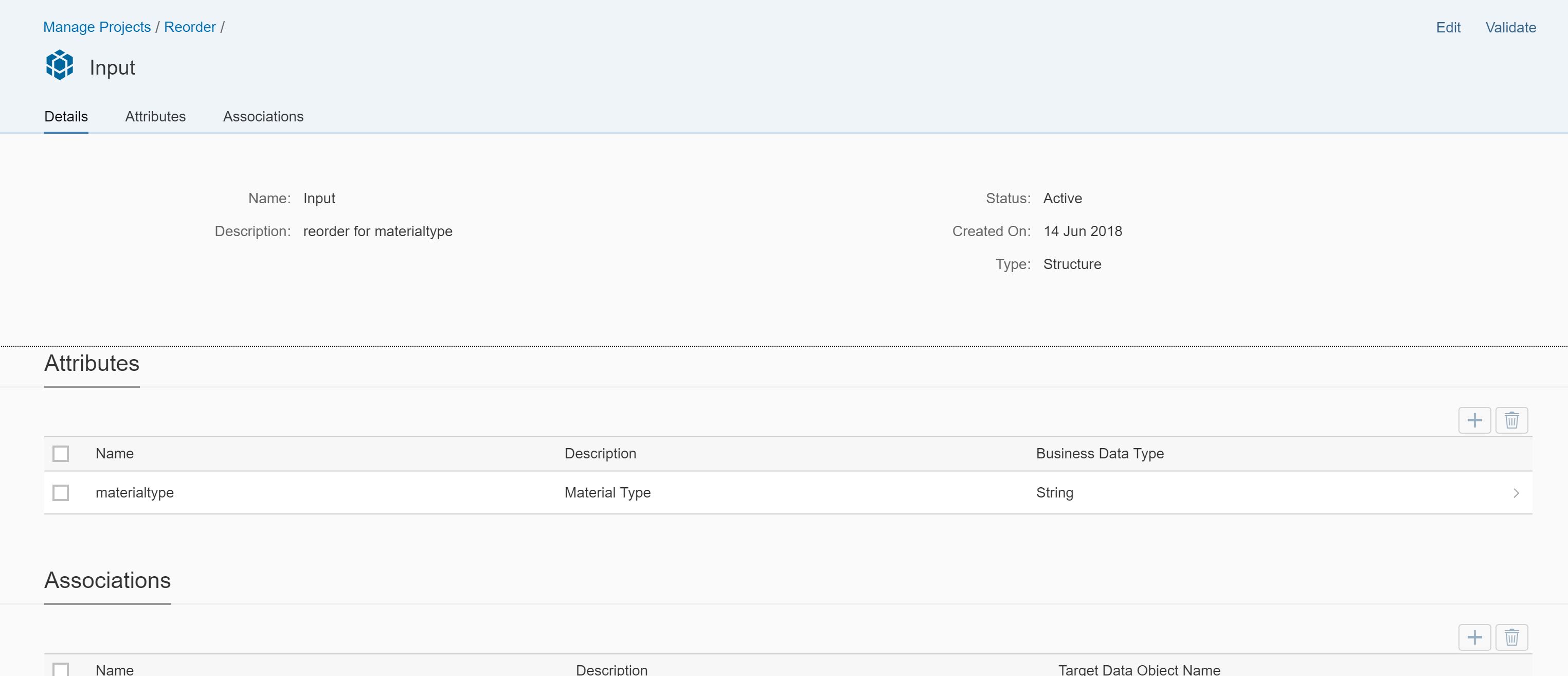
Output: with three attributes as below
ordermode – To indicate whether to place an order automatically or inform the user to place an order after confirmation.
qty – Quantity for reorder
ordertype – Type of Order

Create a Rule.
ReorderRule – This rule is constructed as a Decision Table. Depending on the material type received by the rule different order mode, order type and qty can be sent as output.
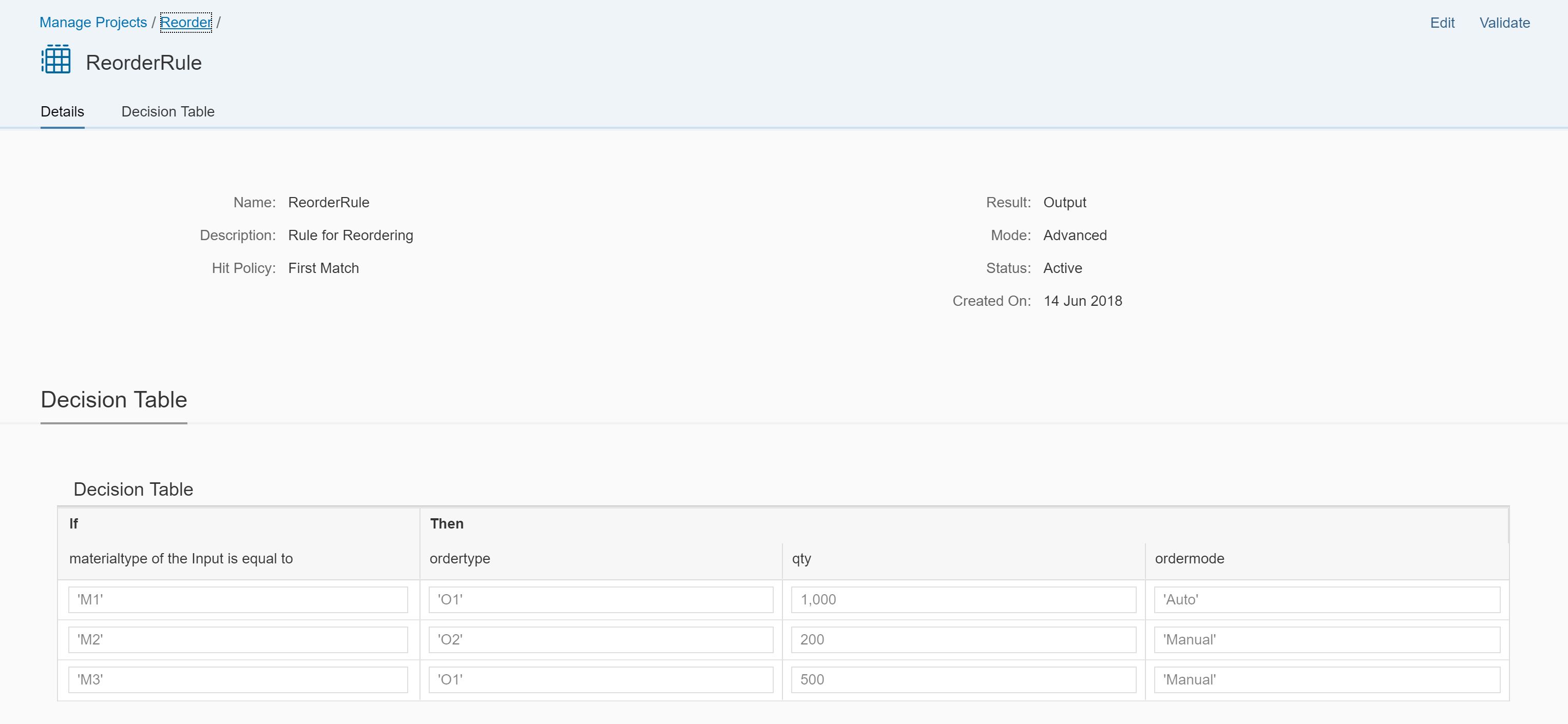
Create a RuleSet
ReorderSet – Add the Rule to the Rule set.

Create a Rule Service
ReorderService – This rule service takes the data object ‘Input’ as input and returns ‘Output’ as result.

Make sure that this rule service is assigned to the rule set. Activate all the objects created in the steps above. Do not forget to deploy the rule service.
The rule service will be called from the IoT application to validate the temperature/humidity from the sensors.
You can test the Business Rule Services by using Postman as shown in the part 2.1 of the blog series.
Step 3: Workflow and User Interfaces
User Interface – UI5 Application for Reorder
Let us first create the user interface which will be displayed to the user when the workflow is triggered.
Open SAP Web IDE (Full Stack) [ URL – https://webidecp-sXXXXXXXXXXtrial.dispatcher.hanatrial.ondemand.com/ ]
Create a simple UI5 application with an XML view as below. Set the page title to ‘Reorder Request for {/materialname}’ and design the screen as shown below. The values for all the variables will be set in the context of the UI5 application by the workflow.

Code mentioned below (in Component.js) is used to set the context variables in the model of the UI5 application.

This piece of code also adds two action buttons which can be used to complete the workflow task. Code lines to complete the current task in the workflow are as below.

Workflow for Reorder
Make sure that the workflow editor feature is enabled in SAP Web IDE.
Create a Workflow project ‘ReOrderProcess’ and create a simple workflow with a single user task – ‘Re-Order Material’. This workflow will be triggered from the IoT Java application.

This user task is linked to the UI5 application created in the step above through the task properties shown below. Choose the HTML5 App Name from the drop down and populate the SAP UI5 Component ID.

Assign your S-ID as the recipient to the user task.
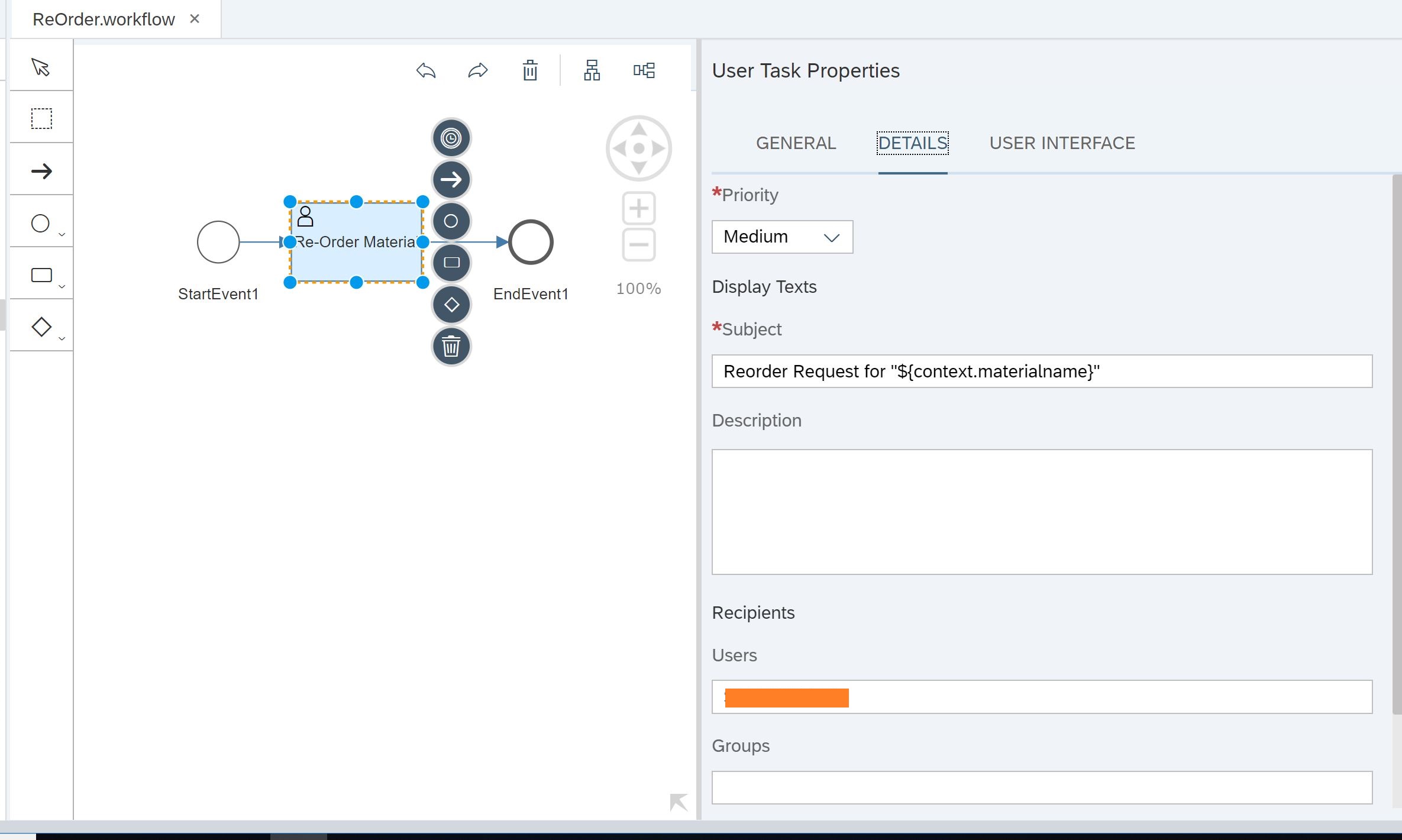
Similar to Business Rules, the workflow can be tested by using one of the following methods
- Use the default apps available in the Fiori Launchpad to create a new instance. Make sure that the context parameters – device name, warning text – are passed.
- Use Postman application to trigger the workflow.
Please refer part 2.2 of the blog series for the steps.
Step 4: IoT Application
Python code snippet written in Raspberry Pi
The reorder sensor sends the values to SCP using the code below. Note that you would require the following values from the IoT cockpit to send sensor values from the device to SCP.
SCP account ID, Host name, Device ID, message type id, Authorization token for the device
http = urllib3.PoolManager()
headers = urllib3.util.make_headers(user_agent=None)
headers['Authorization'] = 'Bearer ' + config.oauth_credentials_for_device
headers['Content-Type'] = 'application/json;charset=utf-8'
url='https://iotmms' + config.hcp_account_id + config.hcp_landscape_host + '/com.sap.iotservices.mms/v1/api/http/data/'+ str(config.device_id)
urllib3.disable_warnings()
try:
while True:
if GPIO.input(buttonPin) == False:
print("low stock message sent")
time = datetime.datetime.now().time()
date = datetime.datetime.now().date()
body= '{"mode":"async", "messageType":"' + str(config.message_type_id_LOW) + '", "messages":[{"Date":'+ ' "' + str(date) + '"'+ ',"Time":'+ ' "' + str(time) + '"'+ ',"Materialtype":'+ ' "M1" }]}'
r = http.urlopen('POST', url, body=body, headers=headers)
print(body)
print(r.data)
except KeyboardInterrupt:
GPIO.cleanup()
IoT application
This is the ‘glue’ application which integrates Step 1, Step 2 and Step 3. The application performs the following steps.
- Read the reorder sensor from the device [use the device ID that we got while registering the device in Step 1]
- Sends the material type to Business rules to get the reorder details depending on the material type. If the order mode from the business rules is ‘auto’ then the order is placed automatically to the relevant system for the qty and the order type received from the business rules. If the order type from the business rules is ‘Manual’, then it triggers an instance of the corresponding workflow definition. This creates a user task in the inbox with the qty and order type received from the business rules.
Code snippet for Step a (for Reorder)
The material type data which comes from the Raspberry Pi is written into table T_LS_IOTMESSAGES as per the service mappings which were done towards the end of Step 1.
Note: if you have not done the process service mappings, then use the default message table name created by the IoT device.
/**
* read data from device
*
* @return
*/
private String getMaterialTypefromDevice(String deviceid) {
InitialContext ctx = null;
DataSource ds = null;
Connection con = null;
String result = null;
try {
ctx = new InitialContext();
ds = (DataSource) ctx.lookup("java:comp/env/jdbc/default");
con = ds.getConnection();
PreparedStatement query = con.prepareStatement(
"SELECT TOP 1 \"C_MATERIALTYPE\" FROM \"SYSTEM\".\"T_LS_IOTMESSAGES\" WHERE \"G_DEVICE\" = '"+deviceid+"' ORDER BY \"G_CREATED\" desc");
ResultSet rs = query.executeQuery();
while (rs.next()) {
result = rs.getString(1);
}
} catch (SQLException e) {
// TODO Auto-generated catch block
e.printStackTrace();
} catch (NamingException e) {
// TODO Auto-generated catch block
e.printStackTrace();
}
return result;
}
Code snippet for Step b.
The code lines below send the material type read from Step a. to the Business Rule Engine to run it through the rules and either places the order or triggers the workflow.
/**
* Get the reorder type and details
*
* @param materialtype
* @return
* @throws ClientProtocolException
* @throws IOException
*/
public String getReorderDetails(String materialname, String materialtype)
throws ClientProtocolException, IOException {
HttpContext httpContext = new BasicHttpContext();
httpContext.setAttribute(HttpClientContext.COOKIE_STORE, new BasicCookieStore());
HttpPost httpPost = null;
CloseableHttpResponse response = null;
CloseableHttpClient httpClient = null;
try {
httpClient = getHTTPClient();
String rulesRuntimeUrl = "https://bpmrulesruntimebpm-s000xxxxxxxtrial.hanatrial.ondemand.com/";
String xsrfTokenUrl = rulesRuntimeUrl + "rules-service/v1/rules/xsrf-token";
String invokeUrl = rulesRuntimeUrl
+ "rules-service/v1/rules/invoke?rule_service_name=Reorder::ReorderService";
httpPost = new HttpPost(invokeUrl);
httpPost.addHeader("Content-type", "application/json");
String xsrfToken = getXSRFToken(xsrfTokenUrl, httpClient, httpContext);
if (xsrfToken != null) {
httpPost.addHeader("X-CSRF-Token", xsrfToken);
}
// replace value of authorizationHeader with base64 encoded value of
// “<user-name>:<password>”
String authorizationHeader = " <base64 encoded value of <user-name>:<password>>";
httpPost.addHeader("Authorization", "Basic " + authorizationHeader);
// construct input data to the rules service
String fact = "{ \"__type__\":\"Input\",\"materialtype\":\"" + materialtype + "\"}";
StringEntity stringEntity = new StringEntity(fact);
httpPost.setEntity(stringEntity);
response = httpClient.execute(httpPost, httpContext);
// process your response here
ByteArrayOutputStream bytes = new ByteArrayOutputStream();
InputStream inputStream = response.getEntity().getContent();
byte[] data = new byte[1024];
int length = 0;
while ((length = inputStream.read(data)) > 0) {
bytes.write(data, 0, length);
}
String respBody = new String(bytes.toByteArray(), "UTF-8");
// The respBody is a JSON and parse is to get discount
ObjectMapper objectMapper = new ObjectMapper();
JsonNode jsonObject = objectMapper.readValue(respBody, JsonNode.class);
String ordermode = jsonObject.get("ordermode").asText();
int qty = jsonObject.get("qty").asInt();
String ordertype = jsonObject.get("ordertype").asText();
if (ordermode.equalsIgnoreCase("Auto")) {
return "Order created - Material: " + materialname + ", Order Type: " + ordertype + ",Quantity: " + qty;
} else {
// trigger workflow
String id = "Order sent to workflow. Workflow instance started with ID "
+ triggerManualReOrder(materialname, materialtype, ordertype, qty);
return id;
}
} finally {
if (httpPost != null) {
httpPost.releaseConnection();
}
if (response != null) {
response.close();
}
if (httpClient != null) {
httpClient.close();
}
}
}
/**
* Gets the xsrf token for business rules/workflow
*
* @param requestURL
* @param client
* @param httpContext
* @return
* @throws ClientProtocolException
* @throws IOException
*/
private String getXSRFToken(String requestURL, CloseableHttpClient client, HttpContext httpContext)
throws ClientProtocolException, IOException {
HttpGet httpGet = null;
CloseableHttpResponse response = null;
String xsrfToken = null;
String authorizationHeader = null;
try {
httpGet = new HttpGet(requestURL);
// replace value of authorizationHeader with base64 encoded value of
// “<user-name>:<password>”
authorizationHeader = "<base64 encoded value of <user-name>:<password>>";
httpGet.addHeader("Authorization", "Basic " + authorizationHeader);
httpGet.addHeader("X-CSRF-Token", "Fetch");
response = client.execute(httpGet, httpContext);
// Fetch the token from response and return
Header xsrfTokenheader = response.getFirstHeader("X-CSRF-Token");
if (xsrfTokenheader != null) {
xsrfToken = xsrfTokenheader.getValue();
}
} finally {
if (httpGet != null) {
httpGet.releaseConnection();
}
if (response != null) {
response.close();
}
}
return xsrfToken;
}
/**
* trigger the reorder process
*
* @param temp
* @return
* @throws ClientProtocolException
* @throws IOException
*/
public String triggerManualReOrder(String materialname, String materialtype, String ordertype, int qty)
throws ClientProtocolException, IOException {
HttpContext httpContext = new BasicHttpContext();
httpContext.setAttribute(HttpClientContext.COOKIE_STORE, new BasicCookieStore());
HttpPost httpPost = null;
CloseableHttpResponse response = null;
CloseableHttpClient httpClient = null;
try {
httpClient = getHTTPClient();
String rulesRuntimeUrl = "https://bpmworkflowruntimewfs-s000xxxxxxtrial.hanatrial.ondemand.com/";
String xsrfTokenUrl = rulesRuntimeUrl + "workflow-service/rest/v1/xsrf-token";
String invokeUrl = rulesRuntimeUrl + "workflow-service/rest/v1/workflow-instances";
httpPost = new HttpPost(invokeUrl);
httpPost.addHeader("Content-type", "application/json");
String xsrfToken = getXSRFToken(xsrfTokenUrl, httpClient, httpContext);
if (xsrfToken != null) {
httpPost.addHeader("X-CSRF-Token", xsrfToken);
}
// replace value of authorizationHeader with base64 encoded value of
// “<user-name>:<password>”
String authorizationHeader = " <base64 encoded value of <user-name>:<password>>";
httpPost.addHeader("Authorization", "Basic " + authorizationHeader);
// construct input data to the workflow service to create instance
String fact = "{ \"definitionId\":\"reorder\",\"context\":{ \"materialname\":\"" + materialname
+ "\",\"materialtype\":\"" + materialtype + "\",\"ordertype\":\"" + ordertype + "\",\"qty\":" + qty
+ "}}";
StringEntity stringEntity = new StringEntity(fact);
httpPost.setEntity(stringEntity);
response = httpClient.execute(httpPost, httpContext);
// process your response here
ByteArrayOutputStream bytes = new ByteArrayOutputStream();
InputStream inputStream = response.getEntity().getContent();
byte[] data = new byte[1024];
int length = 0;
while ((length = inputStream.read(data)) > 0) {
bytes.write(data, 0, length);
}
String respBody = new String(bytes.toByteArray(), "UTF-8");
// The respBody is a JSON and parse is to get discount
ObjectMapper objectMapper = new ObjectMapper();
JsonNode jsonObject = objectMapper.readValue(respBody, JsonNode.class);
return jsonObject.get("id").asText();
} finally {
if (httpPost != null) {
httpPost.releaseConnection();
}
if (response != null) {
response.close();
}
if (httpClient != null) {
httpClient.close();
}
}
}
Finally, the glue code which calls all these functions is as below.
response.getWriter().println(getReorderDetails("Test", getMaterialTypefromDevice(deviceID)));Note that I have hardcoded the material name as ‘Test’ (just because I was too lazy to add this parameter to the IoT device configuration and send it from the sensor. Be aware that there is no way to edit the message type/device type etc once it is created in the IoT cockpit. You have to delete and re-create in case of modifications. This will regenerate all the IDs as well which triggers changes in multiple places ☹)
Do not forget to deploy the Java application in SCP.
I have uploaded the complete java application for Reorder scenario in the link below.
Java Code for the IoT Prototype - Re-Order
Prototype in action
1. Switch on the Raspberry Pi and press the button for the material type ‘M1.
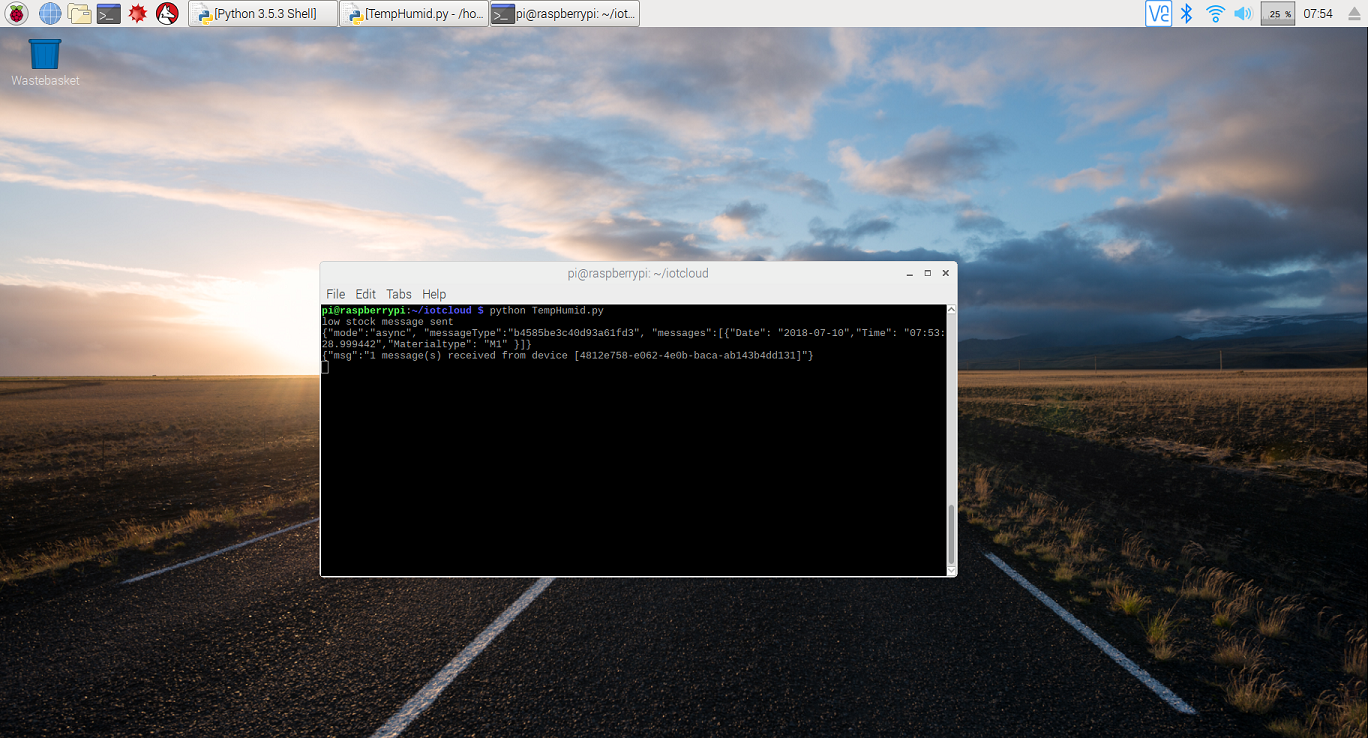
2.You can see the values getting stored in the table which is configured in the Service Mappings – T_LS_IOTMESSAGES.

3. Run the Java servlet with the glue code. In an ideal prototype this part will be scheduled to run in the background. In this prototype, it reads the most recent value from the table and takes action accordingly.
URL – https://iotapplications000XXXXtrial.hanatrial.ondemand.com/IoTApplication/trackStock
You will see that the order is placed automatically (as per the business rules) and the message is displayed.
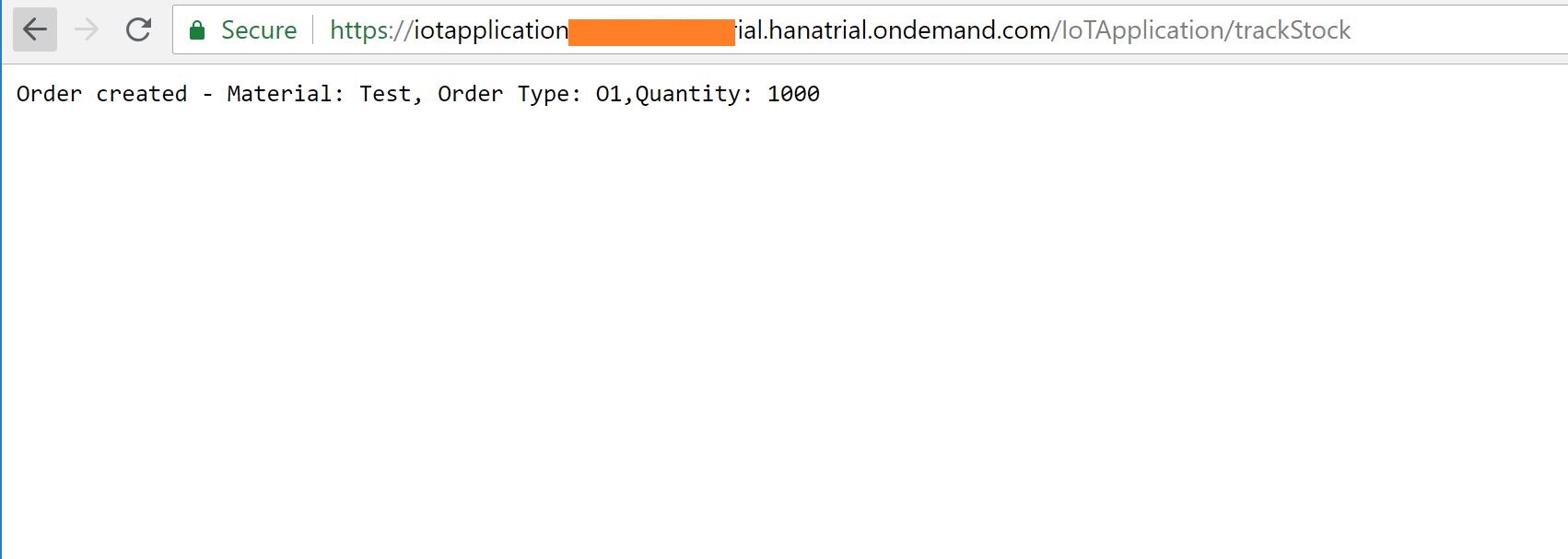
4. Repeat the above steps for material type ‘M2’.


You will see the Workflow Instance for the workflow definition in the Fiori Launch Pad.

You will see a workflow task in the user’s inbox with the alert.

Open the task to view the details

Second scenario is now complete. Please feel free to comment if you have any questions. See you in Part 4 with the final scenario.
You must be a registered user to add a comment. If you've already registered, sign in. Otherwise, register and sign in.
-
"automatische backups"
1 -
"regelmäßige sicherung"
1 -
"TypeScript" "Development" "FeedBack"
1 -
505 Technology Updates 53
1 -
ABAP
14 -
ABAP API
1 -
ABAP CDS Views
2 -
ABAP CDS Views - BW Extraction
1 -
ABAP CDS Views - CDC (Change Data Capture)
1 -
ABAP class
2 -
ABAP Cloud
2 -
ABAP Development
5 -
ABAP in Eclipse
1 -
ABAP Platform Trial
1 -
ABAP Programming
2 -
abap technical
1 -
absl
2 -
access data from SAP Datasphere directly from Snowflake
1 -
Access data from SAP datasphere to Qliksense
1 -
Accrual
1 -
action
1 -
adapter modules
1 -
Addon
1 -
Adobe Document Services
1 -
ADS
1 -
ADS Config
1 -
ADS with ABAP
1 -
ADS with Java
1 -
ADT
2 -
Advance Shipping and Receiving
1 -
Advanced Event Mesh
3 -
AEM
1 -
AI
7 -
AI Launchpad
1 -
AI Projects
1 -
AIML
9 -
Alert in Sap analytical cloud
1 -
Amazon S3
1 -
Analytical Dataset
1 -
Analytical Model
1 -
Analytics
1 -
Analyze Workload Data
1 -
annotations
1 -
API
1 -
API and Integration
3 -
API Call
2 -
API security
1 -
Application Architecture
1 -
Application Development
5 -
Application Development for SAP HANA Cloud
3 -
Applications and Business Processes (AP)
1 -
Artificial Intelligence
1 -
Artificial Intelligence (AI)
5 -
Artificial Intelligence (AI) 1 Business Trends 363 Business Trends 8 Digital Transformation with Cloud ERP (DT) 1 Event Information 462 Event Information 15 Expert Insights 114 Expert Insights 76 Life at SAP 418 Life at SAP 1 Product Updates 4
1 -
Artificial Intelligence (AI) blockchain Data & Analytics
1 -
Artificial Intelligence (AI) blockchain Data & Analytics Intelligent Enterprise
1 -
Artificial Intelligence (AI) blockchain Data & Analytics Intelligent Enterprise Oil Gas IoT Exploration Production
1 -
Artificial Intelligence (AI) blockchain Data & Analytics Intelligent Enterprise sustainability responsibility esg social compliance cybersecurity risk
1 -
ASE
1 -
ASR
2 -
ASUG
1 -
Attachments
1 -
Authorisations
1 -
Automating Processes
1 -
Automation
2 -
aws
2 -
Azure
1 -
Azure AI Studio
1 -
Azure API Center
1 -
Azure API Management
1 -
B2B Integration
1 -
Backorder Processing
1 -
Backup
1 -
Backup and Recovery
1 -
Backup schedule
1 -
BADI_MATERIAL_CHECK error message
1 -
Bank
1 -
BAS
1 -
basis
2 -
Basis Monitoring & Tcodes with Key notes
2 -
Batch Management
1 -
BDC
1 -
Best Practice
1 -
bitcoin
1 -
Blockchain
3 -
bodl
1 -
BOP in aATP
1 -
BOP Segments
1 -
BOP Strategies
1 -
BOP Variant
1 -
BPC
1 -
BPC LIVE
1 -
BTP
12 -
BTP Destination
2 -
Business AI
1 -
Business and IT Integration
1 -
Business application stu
1 -
Business Application Studio
1 -
Business Architecture
1 -
Business Communication Services
1 -
Business Continuity
1 -
Business Data Fabric
3 -
Business Partner
12 -
Business Partner Master Data
10 -
Business Technology Platform
2 -
Business Trends
4 -
CA
1 -
calculation view
1 -
CAP
4 -
Capgemini
1 -
CAPM
1 -
Catalyst for Efficiency: Revolutionizing SAP Integration Suite with Artificial Intelligence (AI) and
1 -
CCMS
2 -
CDQ
12 -
CDS
2 -
Cental Finance
1 -
Certificates
1 -
CFL
1 -
Change Management
1 -
chatbot
1 -
chatgpt
3 -
CL_SALV_TABLE
2 -
Class Runner
1 -
Classrunner
1 -
Cloud ALM Monitoring
1 -
Cloud ALM Operations
1 -
cloud connector
1 -
Cloud Extensibility
1 -
Cloud Foundry
4 -
Cloud Integration
6 -
Cloud Platform Integration
2 -
cloudalm
1 -
communication
1 -
Compensation Information Management
1 -
Compensation Management
1 -
Compliance
1 -
Compound Employee API
1 -
Configuration
1 -
Connectors
1 -
Consolidation Extension for SAP Analytics Cloud
2 -
Control Indicators.
1 -
Controller-Service-Repository pattern
1 -
Conversion
1 -
Cosine similarity
1 -
cryptocurrency
1 -
CSI
1 -
ctms
1 -
Custom chatbot
3 -
Custom Destination Service
1 -
custom fields
1 -
Customer Experience
1 -
Customer Journey
1 -
Customizing
1 -
cyber security
3 -
cybersecurity
1 -
Data
1 -
Data & Analytics
1 -
Data Aging
1 -
Data Analytics
2 -
Data and Analytics (DA)
1 -
Data Archiving
1 -
Data Back-up
1 -
Data Flow
1 -
Data Governance
5 -
Data Integration
2 -
Data Quality
12 -
Data Quality Management
12 -
Data Synchronization
1 -
data transfer
1 -
Data Unleashed
1 -
Data Value
8 -
database tables
1 -
Datasphere
3 -
datenbanksicherung
1 -
dba cockpit
1 -
dbacockpit
1 -
Debugging
2 -
Defender
1 -
Delimiting Pay Components
1 -
Delta Integrations
1 -
Destination
3 -
Destination Service
1 -
Developer extensibility
1 -
Developing with SAP Integration Suite
1 -
Devops
1 -
digital transformation
1 -
Documentation
1 -
Dot Product
1 -
DQM
1 -
dump database
1 -
dump transaction
1 -
e-Invoice
1 -
E4H Conversion
1 -
Eclipse ADT ABAP Development Tools
2 -
edoc
1 -
edocument
1 -
ELA
1 -
Embedded Consolidation
1 -
Embedding
1 -
Embeddings
1 -
Employee Central
1 -
Employee Central Payroll
1 -
Employee Central Time Off
1 -
Employee Information
1 -
Employee Rehires
1 -
Enable Now
1 -
Enable now manager
1 -
endpoint
1 -
Enhancement Request
1 -
Enterprise Architecture
1 -
ESLint
1 -
ETL Business Analytics with SAP Signavio
1 -
Euclidean distance
1 -
Event Dates
1 -
Event Driven Architecture
1 -
Event Mesh
2 -
Event Reason
1 -
EventBasedIntegration
1 -
EWM
1 -
EWM Outbound configuration
1 -
EWM-TM-Integration
1 -
Existing Event Changes
1 -
Expand
1 -
Expert
2 -
Expert Insights
2 -
Exploits
1 -
Fiori
14 -
Fiori Elements
2 -
Fiori SAPUI5
12 -
Flask
1 -
Full Stack
8 -
Funds Management
1 -
General
1 -
General Splitter
1 -
Generative AI
1 -
Getting Started
1 -
GitHub
8 -
Grants Management
1 -
GraphQL
1 -
groovy
1 -
GTP
1 -
HANA
6 -
HANA Cloud
2 -
Hana Cloud Database Integration
2 -
HANA DB
2 -
HANA XS Advanced
1 -
Historical Events
1 -
home labs
1 -
HowTo
1 -
HR Data Management
1 -
html5
8 -
HTML5 Application
1 -
Identity cards validation
1 -
idm
1 -
Implementation
1 -
input parameter
1 -
instant payments
1 -
Integration
3 -
Integration Advisor
1 -
Integration Architecture
1 -
Integration Center
1 -
Integration Suite
1 -
intelligent enterprise
1 -
iot
1 -
Java
1 -
job
1 -
Job Information Changes
1 -
Job-Related Events
1 -
Job_Event_Information
1 -
joule
4 -
Journal Entries
1 -
Just Ask
1 -
Kerberos for ABAP
8 -
Kerberos for JAVA
8 -
KNN
1 -
Launch Wizard
1 -
Learning Content
2 -
Life at SAP
5 -
lightning
1 -
Linear Regression SAP HANA Cloud
1 -
Loading Indicator
1 -
local tax regulations
1 -
LP
1 -
Machine Learning
2 -
Marketing
1 -
Master Data
3 -
Master Data Management
14 -
Maxdb
2 -
MDG
1 -
MDGM
1 -
MDM
1 -
Message box.
1 -
Messages on RF Device
1 -
Microservices Architecture
1 -
Microsoft Universal Print
1 -
Middleware Solutions
1 -
Migration
5 -
ML Model Development
1 -
Modeling in SAP HANA Cloud
8 -
Monitoring
3 -
MTA
1 -
Multi-Record Scenarios
1 -
Multiple Event Triggers
1 -
Myself Transformation
1 -
Neo
1 -
New Event Creation
1 -
New Feature
1 -
Newcomer
1 -
NodeJS
3 -
ODATA
2 -
OData APIs
1 -
odatav2
1 -
ODATAV4
1 -
ODBC
1 -
ODBC Connection
1 -
Onpremise
1 -
open source
2 -
OpenAI API
1 -
Oracle
1 -
PaPM
1 -
PaPM Dynamic Data Copy through Writer function
1 -
PaPM Remote Call
1 -
PAS-C01
1 -
Pay Component Management
1 -
PGP
1 -
Pickle
1 -
PLANNING ARCHITECTURE
1 -
Popup in Sap analytical cloud
1 -
PostgrSQL
1 -
POSTMAN
1 -
Prettier
1 -
Process Automation
2 -
Product Updates
4 -
PSM
1 -
Public Cloud
1 -
Python
4 -
python library - Document information extraction service
1 -
Qlik
1 -
Qualtrics
1 -
RAP
3 -
RAP BO
2 -
Record Deletion
1 -
Recovery
1 -
recurring payments
1 -
redeply
1 -
Release
1 -
Remote Consumption Model
1 -
Replication Flows
1 -
research
1 -
Resilience
1 -
REST
1 -
REST API
2 -
Retagging Required
1 -
Risk
1 -
Rolling Kernel Switch
1 -
route
1 -
rules
1 -
S4 HANA
1 -
S4 HANA Cloud
1 -
S4 HANA On-Premise
1 -
S4HANA
3 -
S4HANA_OP_2023
2 -
SAC
10 -
SAC PLANNING
9 -
SAP
4 -
SAP ABAP
1 -
SAP Advanced Event Mesh
1 -
SAP AI Core
8 -
SAP AI Launchpad
8 -
SAP Analytic Cloud Compass
1 -
Sap Analytical Cloud
1 -
SAP Analytics Cloud
4 -
SAP Analytics Cloud for Consolidation
3 -
SAP Analytics Cloud Story
1 -
SAP analytics clouds
1 -
SAP API Management
1 -
SAP BAS
1 -
SAP Basis
6 -
SAP BODS
1 -
SAP BODS certification.
1 -
SAP BTP
21 -
SAP BTP Build Work Zone
2 -
SAP BTP Cloud Foundry
6 -
SAP BTP Costing
1 -
SAP BTP CTMS
1 -
SAP BTP Innovation
1 -
SAP BTP Migration Tool
1 -
SAP BTP SDK IOS
1 -
SAP Build
11 -
SAP Build App
1 -
SAP Build apps
1 -
SAP Build CodeJam
1 -
SAP Build Process Automation
3 -
SAP Build work zone
10 -
SAP Business Objects Platform
1 -
SAP Business Technology
2 -
SAP Business Technology Platform (XP)
1 -
sap bw
1 -
SAP CAP
2 -
SAP CDC
1 -
SAP CDP
1 -
SAP CDS VIEW
1 -
SAP Certification
1 -
SAP Cloud ALM
4 -
SAP Cloud Application Programming Model
1 -
SAP Cloud Integration for Data Services
1 -
SAP cloud platform
8 -
SAP Companion
1 -
SAP CPI
3 -
SAP CPI (Cloud Platform Integration)
2 -
SAP CPI Discover tab
1 -
sap credential store
1 -
SAP Customer Data Cloud
1 -
SAP Customer Data Platform
1 -
SAP Data Intelligence
1 -
SAP Data Migration in Retail Industry
1 -
SAP Data Services
1 -
SAP DATABASE
1 -
SAP Dataspher to Non SAP BI tools
1 -
SAP Datasphere
9 -
SAP DRC
1 -
SAP EWM
1 -
SAP Fiori
3 -
SAP Fiori App Embedding
1 -
Sap Fiori Extension Project Using BAS
1 -
SAP GRC
1 -
SAP HANA
1 -
SAP HCM (Human Capital Management)
1 -
SAP HR Solutions
1 -
SAP IDM
1 -
SAP Integration Suite
9 -
SAP Integrations
4 -
SAP iRPA
2 -
SAP LAGGING AND SLOW
1 -
SAP Learning Class
1 -
SAP Learning Hub
1 -
SAP Master Data
1 -
SAP Odata
2 -
SAP on Azure
2 -
SAP PartnerEdge
1 -
sap partners
1 -
SAP Password Reset
1 -
SAP PO Migration
1 -
SAP Prepackaged Content
1 -
SAP Process Automation
2 -
SAP Process Integration
2 -
SAP Process Orchestration
1 -
SAP S4HANA
2 -
SAP S4HANA Cloud
1 -
SAP S4HANA Cloud for Finance
1 -
SAP S4HANA Cloud private edition
1 -
SAP Sandbox
1 -
SAP STMS
1 -
SAP successfactors
3 -
SAP SuccessFactors HXM Core
1 -
SAP Time
1 -
SAP TM
2 -
SAP Trading Partner Management
1 -
SAP UI5
1 -
SAP Upgrade
1 -
SAP Utilities
1 -
SAP-GUI
8 -
SAP_COM_0276
1 -
SAPBTP
1 -
SAPCPI
1 -
SAPEWM
1 -
sapmentors
1 -
saponaws
2 -
SAPS4HANA
1 -
SAPUI5
5 -
schedule
1 -
Script Operator
1 -
Secure Login Client Setup
8 -
security
9 -
Selenium Testing
1 -
Self Transformation
1 -
Self-Transformation
1 -
SEN
1 -
SEN Manager
1 -
service
1 -
SET_CELL_TYPE
1 -
SET_CELL_TYPE_COLUMN
1 -
SFTP scenario
2 -
Simplex
1 -
Single Sign On
8 -
Singlesource
1 -
SKLearn
1 -
Slow loading
1 -
soap
1 -
Software Development
1 -
SOLMAN
1 -
solman 7.2
2 -
Solution Manager
3 -
sp_dumpdb
1 -
sp_dumptrans
1 -
SQL
1 -
sql script
1 -
SSL
8 -
SSO
8 -
Substring function
1 -
SuccessFactors
1 -
SuccessFactors Platform
1 -
SuccessFactors Time Tracking
1 -
Sybase
1 -
system copy method
1 -
System owner
1 -
Table splitting
1 -
Tax Integration
1 -
Technical article
1 -
Technical articles
1 -
Technology Updates
14 -
Technology Updates
1 -
Technology_Updates
1 -
terraform
1 -
Threats
2 -
Time Collectors
1 -
Time Off
2 -
Time Sheet
1 -
Time Sheet SAP SuccessFactors Time Tracking
1 -
Tips and tricks
2 -
toggle button
1 -
Tools
1 -
Trainings & Certifications
1 -
Transformation Flow
1 -
Transport in SAP BODS
1 -
Transport Management
1 -
TypeScript
3 -
ui designer
1 -
unbind
1 -
Unified Customer Profile
1 -
UPB
1 -
Use of Parameters for Data Copy in PaPM
1 -
User Unlock
1 -
VA02
1 -
Validations
1 -
Vector Database
2 -
Vector Engine
1 -
Visual Studio Code
1 -
VSCode
2 -
VSCode extenions
1 -
Vulnerabilities
1 -
Web SDK
1 -
work zone
1 -
workload
1 -
xsa
1 -
XSA Refresh
1
- « Previous
- Next »
- Supporting Multiple API Gateways with SAP API Management – using Azure API Management as example in Technology Blogs by SAP
- SAP Build Process Automation Pre-built content for Finance Use cases in Technology Blogs by SAP
- Hack2Build on Business AI – Highlighted Use Cases in Technology Blogs by SAP
- SAP Partners unleash Business AI potential at global Hack2Build in Technology Blogs by SAP
- Publish Message for External System in Technology Q&A
| User | Count |
|---|---|
| 8 | |
| 5 | |
| 5 | |
| 4 | |
| 4 | |
| 4 | |
| 4 | |
| 3 | |
| 3 | |
| 3 |